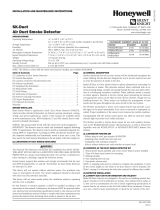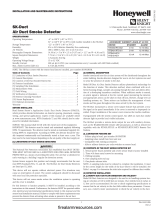
sensor head installation manual. Failure to comply with these requirements
may prevent the detector from activating when smoke is present in the air
duct.
[2] GENERAL DESCRIPTION
Smoke introduced into this air duct system will be distributed throughout the
entire building. Smoke detectors designed for use in air duct systems are used
to sense the presence of smoke in the duct.
Model SK-DUCT-W Air Duct Smoke Detector uses photoelectric technology
for the detection of smoke. This detection method, when combined with an
efficient housing design, samples air passing through the duct and allows de-
tection of a developing hazardous condition. When sufficient smoke is sensed,
an alarm signal is initiated at the fire control panel monitoring the detector,
and appropriate action can be taken to shut off fans, blowers, change over air
handling systems, etc. These actions can facilitate the management of toxic
smoke and fire gases throughout the areas served by the duct system.
The SK-DUCT-W incorporates a sensor cover tamper feature that provides a
trouble signal at the panel immediately if the cover is removed or improperly
installed. Proper installation of the sensor cover removes the trouble condi-
tion.
When programmed with the system control panel, two LEDs on each duct
smoke detector light to provide local visible indication.
The SK-DUCT-W provides a remote alarm output for use with auxiliary de-
vices, such as the RA100Z remote LED annunciator, as well as remote test
capability with the RTS151 or RTS151KEY Remote Test Stations.
[2.1] DETECTOR FEATURE SET
– Uses plug-in head SK-PHOTO-R-W (replaceable, see Section 11.1)
– Sampling tubes install from front and rear
– Compatible with existing accessories
– Able to address detector per code switches on sensor head
[3] CONTENTS OF THE DUCT SMOKE DETECTOR KIT
1. Sensor/power board assembly and covers (with factory-installed sensor
head)
2. Three #10 sheet metal screws for mounting
3. Drilling template
4. One sampling tube end cap
5. One plastic exhaust tube
NOTE: A sampling tube must be ordered to complete the installation. It must
be the correct length for the width of the duct where it will be installed.
See Table 1 on page 2 to determine the inlet tube required for different duct
widths.
TABLE OF CONTENTS PAGE
[1] Limitations of Duct Smoke Detectors ................................................ 1
[2] General Description ......................................................................... 1
[3] Contents of the Duct Smoke Detector Kit .......................................... 1
[4] Detector Installation ....................................................................... 2
[5] Sampling Tube Installation ............................................................... 2
[6] Measurement Tests .......................................................................... 3
[7] Field Wiring; Installation Guidelines ................................................. 4
[8] Verification of Operation ................................................................. 4
[9] Cleaning ......................................................................................... 5
[10] Sensor Replacement ....................................................................... 5
[11] Optional Accessories ..................................................................... 5
BEFORE INSTALLING
Read System Sensor's Applications Guide: Duct Smoke Detectors (HVAG53),
which provides detailed information on detector spacing, placement, zoning,
wiring, and special applications. Copies of this manual are available online
at www.systemsensor.com. NFPA Standards 72 and 90A should also be refer-
enced for detailed information.
NOTICE: This manual shall be left with the owner/user of this equipment.
IMPORTANT: This detector must be tested and maintained regularly following
NFPA 72 requirements. The detector must be tested an maintained regularly
following NFPA 72 requirements. According to NFPA, the detector should be
visually inspected semiannually and functionally tested at least once a year.
This may need to be more frequent depending on the air quality of the duct
supply air.
[1] LIMITATIONS OF DUCT SMOKE DETECTORS
The National Fire Protection Association has established that DUCT DETEC-
TORS MUST NOT BE USED AS A SUBSTITUTE FOR OPEN AREA DETECTOR
PROTECTION as a means of providing life safety. Nor are they a substitute for
early warning in a building’s regular fire detection system.
Fire-Lite supports this position and strongly recommends that the user read
NFPA Standards 90A, 72, and 101. The SK-DUCT-W Air Duct Smoke Detectors
are listed per UL 268A.
This device will not operate without electrical power. Fire situations may
cause an interruption of power. The system safeguards should be discussed
with your local fire protection specialist.
This device will not sense smoke unless the ventilation system is operating
and the cover is installed.
For this detector to function properly, it MUST be installed according to the in-
structions in this manual. Furthermore, the detector MUST be operated within
ALL electrical and environmental specifications listed in this manual and the
I56-6628-000
INSTALLATION AND MAINTENANCE INSTRUCTIONS
SPECIFICATIONS
Specifications
Operating Temperature: –4° to 158°F (–20° to 70°C)
32° to 120°F (0° to 49°C) with module installed in the SK-DUCT-W
Storage Temperature: –22° to 158°F (–30° to 70°C)
Humidity: 0% to 93% Relative Humidity Non-condensing
Air Velocity: 100 to 4000 ft./min. (0.5 to 20.3 m/sec.)
Rectangular Footprint Dimensions: 14.38 in L×5 in W×2.5 in D (37 cm L×12.7 cm W×6.36 cm D)
Square Footprint Dimensions: 7.75 in L×9 in W×2.5 in D (19.7 cm L×22.9 cm W×6.35 cm D)
Weight: 1.8 pounds; 0.82 kg
Operating Voltage Range: 15 to 32 VDC
Standby Current: 200 µA @ 24 VDC (one communication every 5 seconds with LED blink enabled)
Max. Alarm Current (LED on): 6.2 mA @ 24 VDC
NOTE: The SK-DUCT-W comes with the sensor head factory installed, part number SK-PHOTO-R-W.
SK-DUCT-W
Duct Smoke Detector
ACCESSORY CURRENT LOADS AT 24 VDC
DEVICE STANDBY ALARM
RA100Z 0mA 12mA Max.
RTS151 0mA 12mA Max.
RTS151KEY 12mA 12mA Max.
12 Clintonville Road, Northford, CT 06472-1610
Phone: 203-484-7161 Fax: 203-484-7118
www.silentknight.com
1 I56-6628-000
2/26/2019







